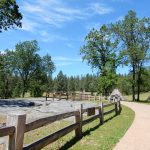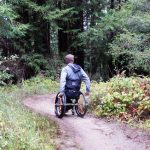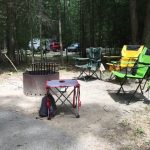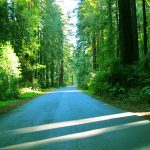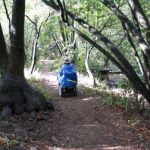Point Cabrillo Light Station State Historic Park sits on a headland that juts dramatically into the ocean on the coast of California; pounding waves have cut channels to the north and south, almost rendering it an island. The park covers 270 acres of coastal bluffs and prairie, and many of the light station’s original buildings (light tower, three keeper’s residences, coal buildings, carpentry shop, smithy, and oil house) still stand today. T
he buildings and the light’s fresnel lens have been extensively restored, along with the surrounding native habitat, thanks to a collaboration between the CA State Coastal Conservancy, State Parks, and the Point Cabrillo Lightkeepers Association, a nonprofit organization created to manage the preserve’s programs as well as the restoration work. The British-made third order fresnel lens is unusual: It is clear rather than the blue hue used in the more prevalent French-made lenses. Only two other British-made lenses remain in operation in the United States. The lightkeeper’s house and two cottages (one wheelchair-accessible) are available as vacation rentals.
The waters around the headland were an important food source for Pomo Indians, who harvested their abundant sea life, including abalone and mussels. Today, these waters are part of the Point Cabrillo State Marine Conservation Area, and no plants or animals may be removed.
Pathway from Lower Lot to Lighthouse
see access criteria for definitions
- Trailhead: Lower parking lot
- Length: Less than .5 mile
- Typical Width: 30 in. to 4 ft.
The park access road is greater than four feet wide. - Typical Grade: Level
If you park in the upper lot and hike the half-mile access road to the lower parking lot and lighthouse, there are some slopes greater than 8 percent. - Terrain: Firm
At the lower parking lot, for a gentler ride to the lighthouse, take the asphalt path that runs parallel to the gravel access road (closed to traffic). - Obstacles: High thresholds into the carpentry shop and lighthouse
Description
Only a few hundred feet of the South Trail by the lower parking lot are accessible, and even that stretch is rough riding on a two-track dirt road. Had I known beforehand about the lack of trail access, I would have parked in the upper lot and taken the park entry road down to the light station. This paved road dips and rises past open grasslands, and will give you the sense of isolation that no doubt was experienced by the lightkeepers who once lived here. From the lower parking lot, a 30-inch-wide walkway leads you past the head lightkeeper’s house, several cottages, the carpentry shop, and the smithy, to the lighthouse a few hundred feet farther.
Accessibility Details
The facilities listed below meet all of our access criteria unless otherwise noted.
- Accessible Visitor Center: Yes
The ramped main entry to the lighthouse visitor center has a three-inch threshold that I couldn’t navigate in a motorized wheelchair. Behind the center there is level entry, but someone must unlock the door for you. Once inside the restored 1904 lighthouse, knowledgeable volunteers from Point Cabrillo Lightkeepers Association are eager to talk about the history of the light station and the timber industry’s evolution in this region. There are displays on the history of the Pomo Indians, including artifacts, and on the sinking of the Frolic, a clipper brig bound for San Francisco during the Gold Rush in 1850. A replica of the ship and a cannon that was rescued by divers are among the exhibits. A small gift shop has books, gifts, and lighthouse and nautical-theme items. Nearby, the blacksmith and carpentry shop contains an exhibit on marine science; a three-inch threshold at the entry limits wheelchair access. Another visitor center, housed in a historic farmhouse at the upper parking lot, is closed until further notice because of State Parks budget cuts. - Accessible Parking: Yes
At upper and lower lot (light station). With a disabled placard you can drive the park access road (only open to authorized vehicles and pedestrians) a half-mile to the light station; otherwise, you can park in the upper lot and walk the half-mile paved access road to the light station. - Accessible Restroom: Yes
State Parks’ website says the restrooms at the visitor center are closed, but they were open during my visit in September. Another restroom is behind the rental property by the lower lot. - Accessible Picnic Tables: Yes
A few picnic tables in the mowed grasslands by the lower parking lot require travel across firm grass. One close to an accessible walkway is behind the lighthouse.
Additional Information
- Hours: Preserve grounds: Sunrise to sunset. Visitor center: Generally open 11 am to 4 pm.
- Map: See here.
- Fees: None
- Dogs: Not allowed



